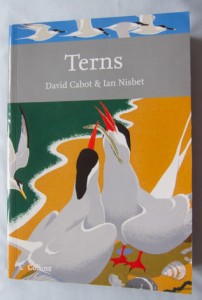Terns by David Cabot and Ian Nesbit is another in the usually excellent Collins New Naturalist series of books. (I say usually excellent only because they are sought after books of which I have only read one other.)
 I bought this book specifically to fill a gap that I discovered in my knowledge following my summer of watching the common terns at the country park last year. I became intrigued by the terns, including the black terns that I saw, and wanted to learn more.
I bought this book specifically to fill a gap that I discovered in my knowledge following my summer of watching the common terns at the country park last year. I became intrigued by the terns, including the black terns that I saw, and wanted to learn more.
The book starts with some general chapters, before moving on to individual chapters about each of the five tern species that breed in Britain and Ireland (I didn’t even know there were five). The first chapters cover the tern family generally, followed by their breeding behaviour and biology, food and foraging techniques, migration and also a history of terns within the British Isles (not good reading – we nearly wiped them out so we could put them on hats). The book finishes with some further information about the terns that are occasionally seen in Britain and Ireland and some notes about conservation projects.
As well as lots of really interesting information presented in a clear and informative way, the book is packed with stunning pictures. My one small criticism is that there is quite a bit of repetition from one chapter to the next, and perhaps the occasional visitors to the UK could be included in the chapter of the tern they are most closely related to. But these are minor criticisms of what was a fantastic book.
So, armed with new knowledge I aim to answer the following questions this summer:
When do the terns first arrive, are they paired before they get here, can I tell the males and females apart by their behaviour in the air, do they defend their territory from when they arrive. Then, hopefully there will be eggs laid, possibly a couple per nest – how long to hatching, if the bad weather comes will they try again, how many of the birds are non-breeding (apparently they often come to scope out a successful feeding ground the year before they are ready to breed), can I tell the different calls apart, how often are the chicks fed, when are they left alone and how long to fledging. Then, there is the question of feeding – what do they feed on and how do they catch it. Finally, how long until they leave and do they all go (adults and chicks) at the same time.
So many questions to be answered – I think I might have a busy summer and perhaps it is as well that it is only the common terns that breed inland in the UK!